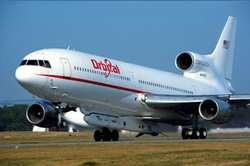Aim To Reduce Costs, Improve Response Times
 Ongoing efforts by
countries such as China to assert footholds in space have added
impetus in the United States to launch more satellites, less
expensively, reports The New York Times.
Ongoing efforts by
countries such as China to assert footholds in space have added
impetus in the United States to launch more satellites, less
expensively, reports The New York Times.
Leading the "more for less" charge are private companies such as
SpaceX, Orbital Sciences, and Microcosm... which are hoping to move
into commercial launch territory now dominated by the likes of
Boeing, Lockheed Martin, French company Arianespace, and Russia's
ISC Kosmotras and Dnepr.
Of those three, Orbital has by far the most experience. Founded
in 1982 to develop smaller, cheaper rocket systems, the Dulles,
VA-based company has 3,300 employees. In the past 12 years, Orbital
has recorded 24 successful launches for its Pegasus system -- which
launches satellites into orbit from below a converted Lockheed
L-1011 airliner.
At about $30 million a pop, Pegasus isn't cheap... which is why
Orbital also offers the lower-cost Minotaur I (below), slated to
send two US Air Force satellites into orbit at a cost of around
$11.5 million apiece.
"We have the capability and reliability," said Orbital VP for
investor relations Barron S. Beneski. "And reliability
doesn’t come cheap." One of the ways Orbital cut costs for
Minotaur, is to use government-supplied rocket engines.

Another company with ambitious plans to grab a chunk of the
commercial satellite market -- which brings in roughly $63 million
a year for Orbital -- is Space Exploration Technologies, or SpaceX.
Founded by Elon Musk, who made his name in the technology sector,
the company has tried to send its Falcon I rocket into orbit
twice.
Both launches failed to achieve orbit, though the rocket came
very close the second time and its propulsion system worked as
designed, Musk says. The company plans a third launch attempt it
January.
Even without a completely successful mission to its credit,
SpaceX has managed to attract strong support... including a $278
million contract from NASA, under its Commercial Orbital
Transportation Services (COTS) program, to develop the larger
Falcon 9 rocket and a cargo transportation module. Musk has kicked
in $100 million of his own money to the company, he adds.

"We can do any payload for one-half to one-third the price of
larger competitors," Musk said, adding he's kicked in around $100
million of his own money to date for SpaceX.
A third entrant into the market is Microcosm, Inc. With only 40
employees, the company -- founded in 1984 -- hasn't garnered the
headlines SpaceX has... but it is working on a USAF contract to
develop a fast-launch rocket system. Dubbed Scorpius Low-Cost
Launch Services, the company is working on a rocket that could send
a payload weighing less than 800 pounds into orbit with eight
hours' notice, for $4.6 million.
"Look at it this way," said Microcosm president James Wertz. "If
we could have launched a satellite within 20 hours of the Asian
tsunami in 2004, we could have found villages needing help right
away rather than a week or two later. We could have saved more
lives."
Such ambitious goals have inherent complications... namely, it's
tough to develop a rocket that's both lightweight, and inexpensive.
As it stands now, the rocket and propellant alone will cost nearly
$4 million per launch, according to Microcosm VP Robert Conger.

The company is working to develop lightweight composite
propellant tanks and thrust systems to contain liquid oxygen under
intense pressures, reports Conger.
Microcosm has worked on Scorpius for eight years... and spent
$65 million in government money, and another $15 million from the
company, on the project. Wertz admits funding is tighter than he'd
like.
"We’ve got $40 million to go," Wertz said, "and these are
challenging times."
 Classic Aero-TV: The Switchblade Flying Car FLIES!
Classic Aero-TV: The Switchblade Flying Car FLIES! ANN FAQ: Q&A 101
ANN FAQ: Q&A 101 ANN's Daily Aero-Term (04.12.24): Discrete Code
ANN's Daily Aero-Term (04.12.24): Discrete Code ANN's Daily Aero-Term (04.13.24): Beyond Visual Line Of Sight (BVLOS)
ANN's Daily Aero-Term (04.13.24): Beyond Visual Line Of Sight (BVLOS) ANN's Daily Aero-Linx (04.13.24)
ANN's Daily Aero-Linx (04.13.24)





